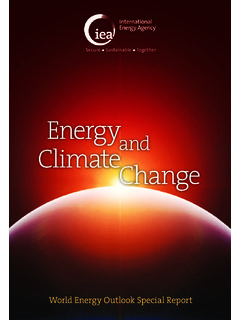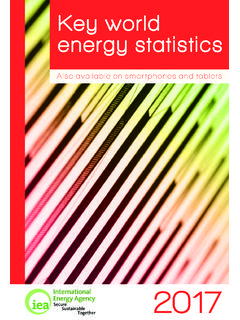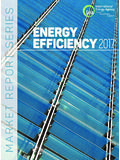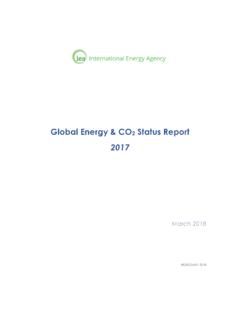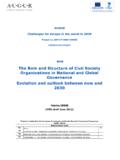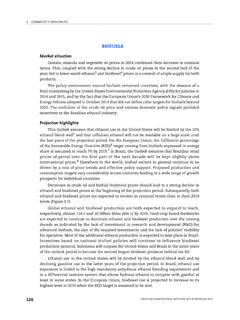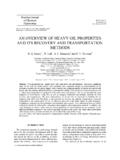Transcription of People’s Republic of China - International Energy …
1 people s Republic of China Key Figures _____ 2 Overview _____ 3 1. Energy outlook _____ 4 2. Oil _____ 5 Market Features and Key Issues _____ 5 Oil Supply Infrastructure _____ 8 Decision-making Structure for Oil Emergencies _____ 11 Stocks _____ 11 3. Other Measures _____ 13 4. Natural Gas _____ 14 Market Features and Key Issues _____ 14 Natural gas supply infrastructure _____ 16 Emergency Policy for Natural Gas _____ 18 List of Figures Total Primary Energy Supply ---------------------------------------- ---------------------------------------- --------------------- 4 Electricity Generation, by Fuel Source ---------------------------------------- ---------------------------------------- -------- 4 Domestic Oil Production and Demand ---------------------------------------- ---------------------------------------- -------- 5 Oil Demand in 2009 (kb/d) ---------------------------------------- ---------------------------------------- ----------------------- 5 Oil Consumption, by Product ---------------------------------------- ---------------------------------------- -------------------- 6 Crude Oil Import by Source ---------------------------------------- ---------------------------------------- ---------------------- 6 Oil Storage Capacity ---------------------------------------- ---------------------------------------- -------------------------------- 9 Oil Infrustructure Map ---------------------------------------- ---------------------------------------- --------------------------- 10 Chinese Strategic Petroleum Reserve Sites ---------------------------------------- ---------------------------------------- 12 Natural Gas Consumption, by Sector ---------------------------------------- ---------------------------------------- -------- 14 LNG Imports.
2 By Source ---------------------------------------- ---------------------------------------- ------------------------- 15 Natural Gas Infrastructure Map ---------------------------------------- ---------------------------------------- --------------- 17 Note: This section on China was written by the IEA, based on public information, IEA statistics, press reports and reports from various Energy analysts, and does not represent the official view of the Chinese government. All errors and omissions are solely the responsibility of the S Republic OF China 2 China Key Oil Data 1985 1990 1995 2000 2005 2007 2008 2009 Production (kb/d) 2, 2, 3, 3, 3, 3, 3, 3, Demand (kb/d) 1, 2, 3, 4, 6, 7, 7, 8, Motor - gasoline 1, 1, 1, 1, Gas/diesel oil 1, 2, 2, 2, 2, Residual fuel oil Others Net imports (kb/d) Import dependency Oil in Total Energy Consumption Source.
3 Calculated by the IEA based on China Energy Statistical Yearbook 2010, National Bureau of Statistics of China , China Statistics Press Key Natural Gas Data 1985 1990 1995 2000 2005 2007 2008 2009 Production (mcm/y) 12,930 15,300 17,950 27,200 49,320 69,240 80,299 85,269 Consumption (mcm/y) 12,930 15,250 17,741 24,503 46,763 70,523 81,294 89,520 Industry 10,960 12,020 15,440 19,900 32,879 47,967 53,160 57,790 Construction 1,410 1,060 30 82 149 209 99 100 Transport, Storage and Post 80 190 160 881 3,801 4,689 7,155 9,110 Wholesale, Retail Trade and Hotels, Restaurants - - 60 344 1,079 1,711 1,775 2,400 Residential Consumption 430 1,860 1,940 3,232 7,943 14,339 17,012 17,770 Others 50 120 120 64 912 1,609 2,092 2,360 Net imports (mcm/y)
4 - - - -3,140 -2,970 1,420 1,350 4,420 Import dependency Gas in Total Energy Consumption Source: Calculated by the IEA based on China Energy Statistical Yearbook 2010, National Bureau of Statistics of China , China Statistics Press people S Republic OF China 3 OVERVIEW Although coal is the dominant Energy source in China , accounting for some 70% of the country s Total Energy Consumption (TEC) in 2009, oil and gas are also essential Energy sources. Despite strong growth in consumption of oil, its share of TEC fell from 22% in 2000 to 18% in 2009, as coal use rose even faster to meet burgeoning demand for electricity.
5 A strong policy push boosted natural gas supplies, particularly to residential customers, so that the share of natural gas doubled from 2% in 2000 to 4% in 2009. China is one of the important oil and natural gas producing counties in the world. In 2010, China s crude oil production exceeded 4 million barrels per day (mb/d). However, with strong and sustained economic growth, its demand for oil has also increased, from mb/d in 2000 to over 8 mb/d in 2009. In the New Policy Scenario (NPS) of the IEA World Energy outlook (WEO) 2011, China s primary oil demand rises to mb/d in 2020. Although China is now the world s fifth-largest oil producer, the country has been a net oil importer since 1993. In 2011, China imported over 5 mb/d of crude oil, accounting for about 54% of its total demand. More than 50% of the total crude oil imports came from counties of the Middle East.
6 To prevent a potential shock to the economy caused by an oil supply disruption, the Chinese government has been steadily pushing building an oil stock reserve system. China has completed four stockpiling facilities with a capacity of around 103 mb in the first phase of its Strategic Petroleum Reserve (SPR) plan, and has begun construction of its second phase, which comprises eight storage sites that will reportedly have a combined capacity of around 207 mb. Among them, two sites were completed in the second half of 2011 and the Tianjin site is reportedly set to be completed in 2012. According to unofficial reports, the remaining four SPR-II sites are expected to become operational by 2013. The third phase is expected to boost total SPR capacity to approximately 500 mb by 2020. Stockholding obligations for industry may be considered, but are not now a formal part of the emergency response system, authorising legislation for which is still in preparation.
7 Domestic natural gas production surged from about 27 bcm in 2000 to bcm in 2010, or a compound average growth of 14% annually. In 2010, domestic supplies met 90% of domestic consumption. As natural gas use has grown, China started importing LNG in 2006 and became a net importer in 2007. In 2010, gas demand reached around 106 bcm (290 mcm/d), while it is estimated to have increased to 130 bcm in 2011. China imports natural gas both in the form of LNG and through gas pipelines. By country, China imported LNG from Australia (5 bcm), Qatar ( bcm) and Indonesia ( bcm) in 2011. The key elements of China s approach to gas security are to further promote domestic production from conventional and unconventional resources, to expand reserves, to construct gas storage facilities, and to accelerate construction of LNG terminals and interregional gas pipelines in order to strengthen supply of gas imports.
8 Although China does not have government gas stocks or mandatory industry stocks, the government promotes the expansion of commercial inventories. So far, some storage facilities have been built for coping with seasonal demand fluctuations. people S Republic OF China 4 1. Energy outlook With economy development, China s Energy consumption increased gradually in recent years. In 2009, China s Total Energy Consumption (TEC) reached around billion toe. The Energy mix of the TEC remained relatively unchanged over the past 30 years: coal accounted for around 70% in 2009, followed by oil (18%) and natural gas (4%). According to China s Energy Development Report 2011, in 2009 the indigenous production of coal met its domestic demand, while more than half of oil demand depended on imports. Total Primary Energy Supply Source: calculated by the IEA based on China s Energy Development Report 2011, National Energy Administration of China In order to enhance Energy security, the Chinese government has attached more importance to Energy efficiency.
9 According to China s Energy Development Report 2011, 12th 5-year Energy plan, the Administration has a target for Energy consumption to keep less than billion toe/year by 2015. Electricity Generation, by Fuel Source Source: Energy Balances of Non-OECD Countries 2011, IEA 1980co ,150 million toe 420 million toe people S Republic OF China 5 2. Oil Market Features and Key Issues Domestic oil production In 2010, China s crude oil production has increased to million b/d (203 million tons), exceeding 4 mb/d (200 Mt) for the first time. China s remaining proven oil reserves have steadily grown since 2000 due to exploration in the Northwest and offshore, where oil production increased by 60% and 24% in 2009 respectively, compared to 2000. China s offshore oil production rapidly increased in 2010, reaching mb/d ( Mt), accounting for 23% of the total oil production of the country.
10 In contrast, oil production in the Northeast has gradually decreased each year. To secure oil supplies, the main state-owned oil companies have enhanced investment in domestic and foreign oil exploration in recent years, and crude oil production is expected to remain relatively stable. Domestic Oil Production and Demand Source: Calculated by the IEA based on China Energy Statistical Yearbook 2010, National Bureau of Statistics of China , China Statistics Press Oil demand China s total oil demand in 2009 averaged around 8 mb/d (385 Mt). It has been rising rapidly from mb/d (225 Mt) in 2000, increasing by a compound average growth rate of Overall demand is expected to continue along this gradual increasing trend. Under the assumptions of the New Policy Scenario (NPS) in the IEA s World Energy outlook (WEO) 2011, China s primary oil demand would rise to mb/d in 2020 and almost 15 mb/d in 2035.


